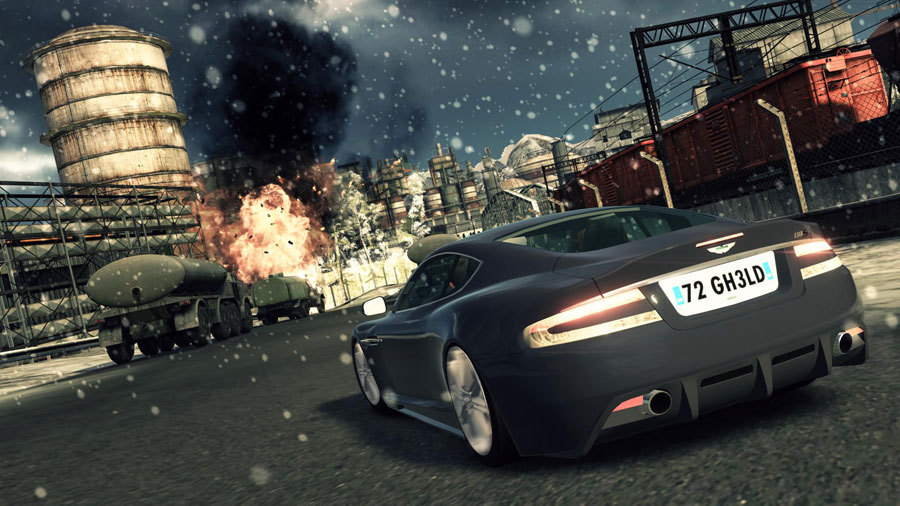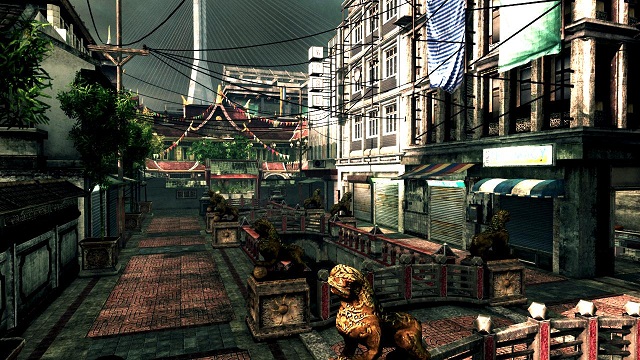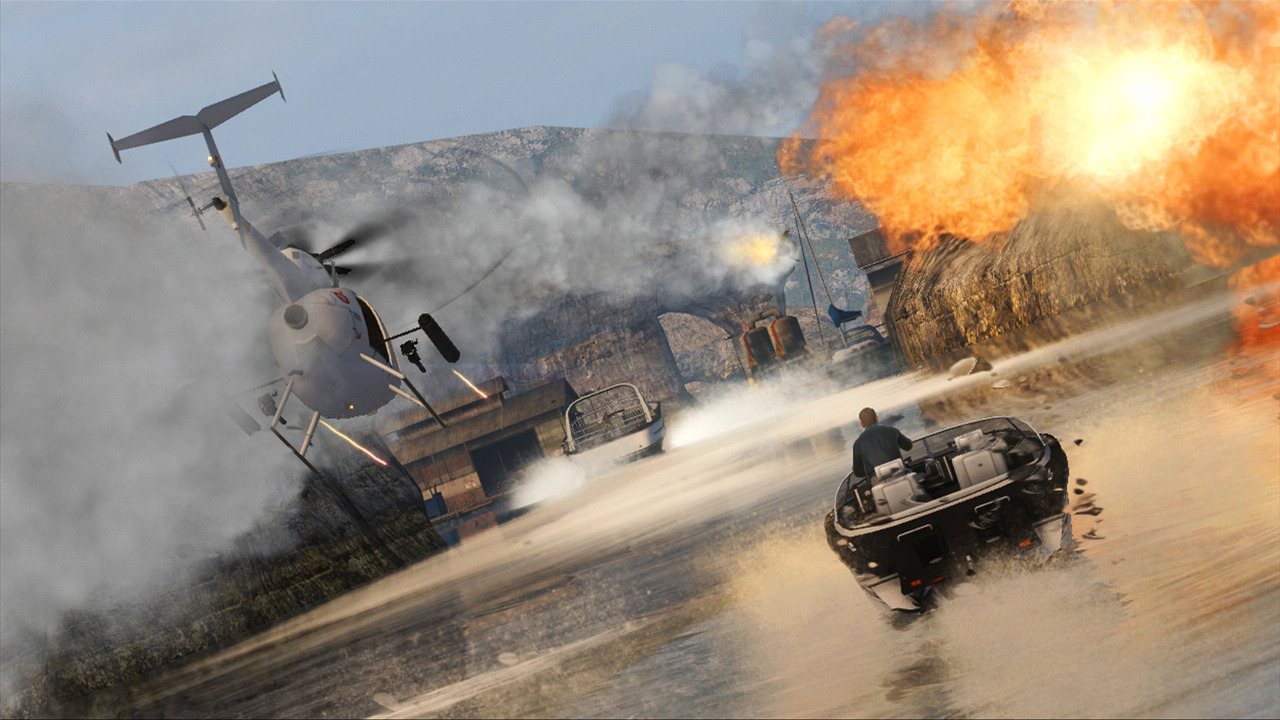James Bond 007: Blood Stone takes on many action game styles, and while it does each of them fairly well, the overriding concern of the game is impressing a sense of dramatic flair and urgency upon the player. Developer Bizarre Creations has had a solid resume in driving titles, including such popular hits like the Project Gotham series, but also has shown itself to be a capable shooter developer in this title.
 The game consists of two gameplay modes: on-foot sequences that combine exploration, and 3rd-person shooter combat with stealth elements. Then there are the driving sequences that involve chasing a fleeing villain through city streets, hills and construction sites, narrowly avoiding hazards and dodging traffic. Bond’s adventures in this latest title take him from catacombs being dug out (get ready for a crazy scene in which the player must outrun a massive drilling machine) to a casino in Monaco, an oil refinery in Siberia, the streets of Bangkok, to a harsh Burmese prison and hydroelectric plant. The characters, like Bond Girl Nicole and Supervillain Rak feel like authentic Bond figures and fill their respective niches well, with Nicole extruding a femme fatale vibe and Rak the appropriate level of capability and malevolence.
The game consists of two gameplay modes: on-foot sequences that combine exploration, and 3rd-person shooter combat with stealth elements. Then there are the driving sequences that involve chasing a fleeing villain through city streets, hills and construction sites, narrowly avoiding hazards and dodging traffic. Bond’s adventures in this latest title take him from catacombs being dug out (get ready for a crazy scene in which the player must outrun a massive drilling machine) to a casino in Monaco, an oil refinery in Siberia, the streets of Bangkok, to a harsh Burmese prison and hydroelectric plant. The characters, like Bond Girl Nicole and Supervillain Rak feel like authentic Bond figures and fill their respective niches well, with Nicole extruding a femme fatale vibe and Rak the appropriate level of capability and malevolence.

The vehicular sections mainly depend on the player not crashing into anything at all while forcing the player to remain at top speed for the duration of the excessively long tracks, often not including checkpoints until after a series of difficult navigations. When factoring in your vehicle’s tendency to fishtail and slide across ice and concrete with equal lack of traction, the hectic action often causes an error that the game does not forgive; players are forced to replay long stretches of track that are marked by scripted sequences which generally define the driving stages, making an otherwise exciting and dramatic chase become an exercise in trial and error.

The shooter segments of Blood Stone seem to be much deeper and developed than the fairly arcadey and simplistic driving sequences. Despite this, the player only gets to make use of a limited selection of weapons; the default P99 is always part of Bond’s arsenal and cannot be exchanged for any other weapon, while a second slot allows for found weapons that are silenced or loud depending on where you find them. The weapons themselves fall into six categories, including pistols, sub-machine guns, assault rifles, sniper rifles, shotguns and a grenade launcher. Most of the weapons types are similar within their own class, such as SMGs firing fast and reloading fast but are weak overall, assault rifles powerful and accurate but slow to reload.
One notable feature that encourages differing tactics is the inclusion of the “Focus Aim” system, a gauge that saves up to 3 instant ranged kills, accumulated by killing enemies in melee. When enemies are within melee range, the player can choose to instantly kill the enemy though a context-sensitive takedown animation which changes depending on the environment; this mechanic makes stealth kills and normal melee takedowns varied and interesting as Bond rams some sucker’s head into a nearby wall or just smashes his crotch with a well placed punch or knee. Each kill Bond makes in this manner earns him one Focus Kill which illuminates and auto-targets the closest enemy to the aiming reticule while also slowing time for a short time, allowing the player to fire one bullet of their current weapon into said enemy, earning an instant kill. Outside of this mechanic, Headshots earn instant kills while torso and limb hits cause lesser damage but causes the enemy to recoil in pain for a short time. Nearby hits to walls and areas around enemies causes them to jump back and run to cover, adding to some aspect of realism that often is overlooked.
Often, stages and areas begin by having Bond in a state of stealth, in which enemies are unaware of his presence and allows the player to sometimes negotiate stages with other any combat at all. The ubiquitous cover system allows the player to attach to surfaces, automatically adjusting his stance based on how tall the cover is. The player can utilize this cover to hide from enemies and can automatically sprint between cover areas to avoid being seen. As in other cover-based shooters, the player has the option to emerge from cover to shoot enemies, but he can also blind fire around corners that actually forces other enemies behind cover to be suppressed and hide, allowing you to have more time to take shots.
Bond’s smartphone is an integral part of the foot sequences, often being required to interact with technological devices such as bugs, electronic locks and cameras. It is also used to bring up an overlay which identifies the location of enemies (including their weapons and alert state), objects of interest, explosives, and waypoints. It comes in handy in figuring out plans of attack or how best to deal with enemies; it kind of made the game a lot easier than it may have been otherwise. Unlike pretty much every other Bond title, the smartphone is the unfortunately only gadget available in the arsenal. The lack of offensive gadgets made combat fairly predictable exercise, and highlighted a weakness that could’ve been filled with all sorts of creative applications. The regenerating health system is nearly identical to Modern Warfare’s bloody borders, requiring a short stay behind cover to regain health.
The game’s console port status is obvious through the implementation of a checkpoint system rather than a more PC-friendly save system, as well as focus on keyboard menu navigation rather than through the mouse. The graphics aren’t up to today’s standards in several respects, showing noticeably low-resolution textures on many background objects. The environments consist mainly of enclosed areas with smatterings of obvious waist-high cover for your use.

There is a multiplayer component as well, where up to 16 players fight as 00 agents or enemy mercenaries in team deathmatch and rush-style objective modes (essentially attack and defend scenarios) over 8 different stages. Blood Stone borrows from popular shooters like Bad Company and Modern Warfare in that it grants persistent ranks, skins and weapons to players as they earn experience and achievements. The top player at any one time takes a hero skin for their respective sides, so James Bond for the 00 agents and Rak for the mercenaries; it doesn’t grant any powers, other than bragging rights.
James Bond 007: Blood Stone is overall a game that is better than the sum of its parts, mainly due to the appropriately engaging plot and characters that are strong presences in of themselves. The actual action sequences provide a sense of critical need and the gameplay mechanics encourage aggressive behavior. These parts are hurt by the relative mediocre variety of equipment Bond has in pursuing these objectives, which in of themselves are often simplistic pull-the-switch exercises. Blood Stone was released on November 2nd, 2010 in North America and November 5th in Europe for the Playstation 3, Xbox360, Nintendo DS and PC.